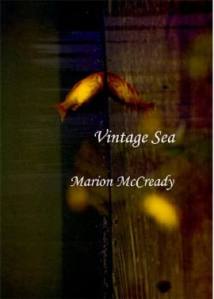‘Vintage Sea’ by Marion McCready
-Reviewed by Mark Burnhope–
If reading McCready’s debut pamphlet puts me in mind of two or three poets in particular, that’s not to say anything, necessarily, about wearing influences on sleeves. It’s probably fairer to say that Vintage Sea carries its salt in its water. Sylvia Plath is ever-present here, but rather than appearing in a thick oil of confession, her influence is diffused across the pamphlet, in images, motifs, rhythms and sounds which together form McCready’s sense of place (the Firth of Clyde, and the islands off Scotland’s west coast, rather than Plath’s Yorkshire moors). One recurring motif is the sea as bringer and breaker of life. ‘The Herring Girl’ reads almost as the feminine echo of Plath’s ‘Full Fathom Five’:
Under a cloud of shoals she lies.
The peaty moon
rising from her knees,
sailing the length of her curves.
Her herring bone hands
hang by her side.
There’s a subtle but palpable motif of birth and miscarriage in ‘The Captayannis’, which makes effective metaphorical use of Greek mythology (the three goddesses of vengeance named the Furies are evoked), and the Greek sugar-carrying vessel which sank in the River Clyde in 1974. I’m not entirely convinced by the confusion of the first two lines in this portion, or ‘buried / like a treasure’, but the poem is affective, and affecting, overall:
A part of me crept inside her
while she slept in my womb,
smaller than a plumb.
I imagined I could keep her buried
like a treasure. But even the Captayannis
could not keep her cargo.
Throughout Vintage Sea is the accumulation and distillation of things that Plath did well – situating the self in / seeing the self through landscape; myth-making as a way of making sense of experience – but without the baggage of vitriol that (sadly) makes so many contemporary readers recoil. That’s not to say that McCready shrinks back from intense feeling, but that like a seashore forager, she often draws our attention to the subtler elements we might have missed in our distaste for the depressive and melancholy. On one hand, McCready’s lyrical ‘I’ pushes through its sadness to find escape from Plath’s claustrophobic ‘Wuthering Heights’ horizons:
My hair rests on the waist
of the North Sea.
My dress balloons around me.
I am evergreen, never shedding tears or leaves.
Yet this evening I have cried a loch
into my bed. I sleep,
I sleep with a breath. I dream
castle ruins, wet sand and steps
that sink to seas. I think
I may be swimming to Norway.
I think I may be free.
On the other hand, that Plathean darkness is still here (the Herring Girl ‘slits throats in her sleep’) but it’s distilled, filtered perhaps through Williams’ ‘No ideas but in things’ dictum, or Pound and the Imagists’ almost unwavering reliance on imagery. In ‘Bramble Street’, the suicide idea is built into the things of language via metaphor and simile. The poem finishes two strophes too late for me, and the final lines are too neatly conclusive. But overall, this searing subtlety is one of McCready’s hallmarks:
They ripen to mosaics,
sweet stains hanging mid-air.
Then one by one
they succumb
like a family of suicides.
Of course, that ‘No ideas but in things’ idea, like others, has been further developed in contemporary poetry. Even Wallace Stevens was getting tired of the separation of ‘ideas’ from ‘things’ when he began to conflate the two in his later work. Similarly, whilst McCready doesn’t doubt the essential ‘thingness’ of the image, it isn’t quite enough, so her poems are filled with multi-sensory effects: words, images, rhythms and sounds are often very carefully chosen to get at every one of the senses, as if we ourselves were able to walk these lands and seascapes. So many lines (too many to quote) from ‘Sargassum Lullaby’, ‘The Cockle Picker’s Wife’ and ‘Life Rafts’ are tactile, smelly, tasty.
My favourite poems here are highly musical, and their sparse forms, clipped lines and taut linebreaks support their close sound recurrences and small units of meaning. In this, I’m reminded of Elizabeth Bishop, who was also at her best when she zoomed into small poetic ingredients. The concentration on the ‘bones’ of language in poems like ‘In the Waiting Room’ and ‘The Fish’ gave us pause for contemplation at various lines, lifting words which might have otherwise seemed plain, to higher metaphorical or symbolic significance. This placing of language elements in close proximity can have its pitfalls, one of which is that clichéd or simply well-worn phrases can appear too prominent. But a second, related problem can happen when McCready’s lines are unravelled (indeed, even the longer lines of Bishop’s ‘One Art’ are arguably too reliant on the villanelle’s form and metre to achieve their effects). McCready writes largely in free verse, but I can’t help wondering if her longer lines are more forgiving of, and better at hiding, the occasional awkward abstraction, slightly tired image or trite rhyme:
There are bodies in the surf, a face in every crest and fall.
You carry her in your tummy, alive. Your wallet hides her soul.
What did you do to her? You swallowed her whole.
Aside from these hesitations, there’s much to admire and be transfixed by in Vintage Sea. I warmly recommend it, and look forward to seeing how McCready’s work develops.




